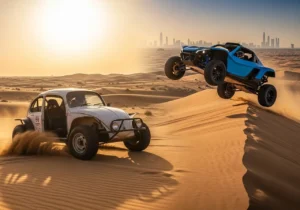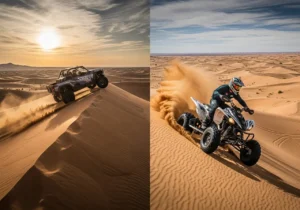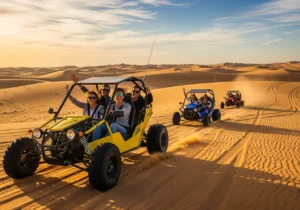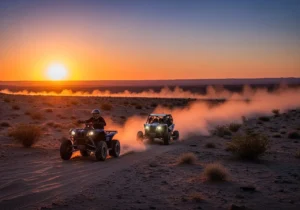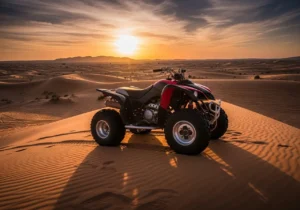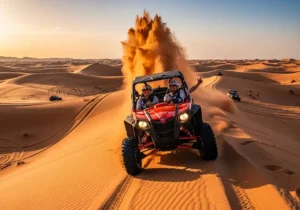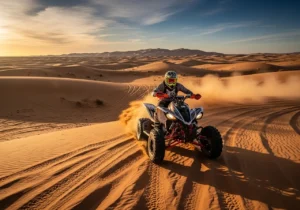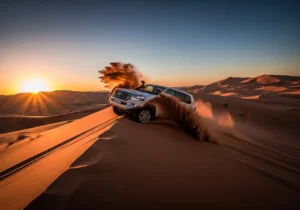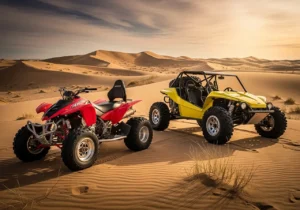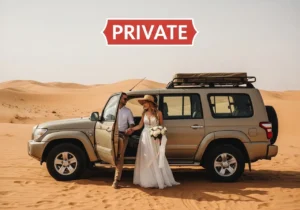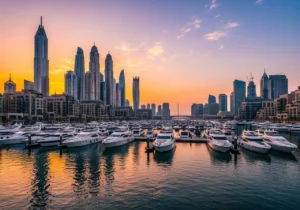Capturing the Rush: The Ultimate Guide to ATV Desert Adventure Photography
The roar of the engine, the spray of golden sand, the exhilarating freedom of carving your own path across the majestic dunes—an ATV ride is the heart of a true desert adventure. This is your ultimate guide to ATV Desert Adventure Photography, a deep dive into the art of capturing the thrill, the scale, and the breathtaking beauty of this incredible experience.
This in-depth exploration will take you on a journey through every aspect of shooting in this dynamic and challenging environment. This is more than just a list of tips; it is a comprehensive masterclass in ATV Desert Adventure Photography, designed to help you transform your 2025 holiday snaps into spectacular, professional-looking action shots.
We will delve into the essential gear you need and, crucially, how to protect it from the desert’s biggest enemy: sand. We will unlock the secrets of the perfect camera settings to freeze the action and explore the artistic composition techniques that will make your images pop.
Prepare to move beyond simple point-and-shoot and start creating images that truly convey the adrenaline and the awe of the moment. Whether you are using a high-end DSLR or the smartphone in your pocket, this guide to ATV Desert Adventure Photography will provide you with the knowledge and confidence to capture the adventure of a lifetime.
Preparing for the Shoot: Essential Gear and Critical Protection
The foundation of great ATV Desert Adventure Photography is having the right gear and, more importantly, knowing how to protect it. The desert is a beautiful but harsh environment for electronics.
Choosing Your Weapon: The Right Camera for the Job
- Action Cameras (The Top Choice):
- The GoPro Advantage: For capturing the ride itself, an action camera like a GoPro is the undisputed king. They are small, rugged, and designed for exactly this kind of adventure.
- Key Features: Their ultra-wide field of view is perfect for capturing an immersive first-person perspective, and their industry-leading electronic image stabilization (like HyperSmooth) is essential for getting smooth, watchable footage, even on the bumpiest of rides.
- DSLR and Mirrorless Cameras (For the Stops):
- The Quality Factor: For the highest possible image quality, especially for portraits and landscape shots during the photo stops, a DSLR or a mirrorless camera is unbeatable.
- The Risk: However, these cameras are very vulnerable to sand damage. The fine desert sand can easily get inside the camera body or between the lens elements, causing serious and expensive damage. They should only be used during designated stops and with extreme care.
- Smartphones (The Convenient All-Rounder):
- Incredible Capability: Modern smartphone cameras are incredibly powerful. They are perfect for capturing quick videos and stunning photos during the breaks in your ride.
- Protection is Key: Even with a smartphone, it is crucial to use a protective, sand-proof case to keep it safe.
The Art of the Mount: Getting the Best Angles
For an action camera, the way you mount it will completely define your shots.
- The Helmet Mount: This is the classic choice for a true first-person Point of View (POV). It captures the adventure exactly as you see it, showing your handlebars and the trail ahead. This is a fantastic angle for immersive ATV Desert Adventure Photography.
- The Handlebar Mount: Mounting the camera on the handlebars provides a stable and centered view of the trail. It is also great for capturing your own reactions if you angle it back towards yourself.
- The Chest Mount: A chest mount offers a lower, more dynamic perspective than the helmet mount. It is very immersive as it captures your hands on the handlebars, making the viewer feel like they are the one in control of the ATV.
The Nemesis: Protecting Your Gear from Sand
Sand is the mortal enemy of any camera. Protecting your gear is the most important part of this ATV Desert Adventure Photography guide.
- Use Protective Housings: For DSLRs and mirrorless cameras, a simple rain cover or even a clear plastic bag can provide a great deal of protection from blowing sand.
- The Danger of Changing Lenses: This is the most dangerous moment for your camera. Never, ever change your lens in the open desert. If you must change it, do it inside a sealed vehicle with the windows closed and the air conditioning off.
- The Power of a UV Filter: A simple, inexpensive UV filter screwed onto the front of your lens acts as a sacrificial barrier, protecting the expensive front element of your lens from scratches.
- Keep it Sealed: When you are not actively shooting, keep your camera inside a sealed, high-quality camera bag.
- Cleaning Your Gear Post-Ride: After your adventure, do not wipe the sand off your camera with a cloth, as this will scratch it. Use a can of compressed air or a photographer’s blower to gently blow all the sand and dust off your gear before you attempt to wipe it clean.
Mastering the Settings: A Technical Guide
Taking your camera off “Auto” is the key to unlocking creative and professional-looking ATV Desert Adventure Photography.
For Action Cameras (GoPro)
- Resolution and Frame Rate: The Big Decision:
- 4K at 30fps (Frames Per Second): This will give you the highest resolution and the most detail. It is perfect for capturing the stunning scenery.
- 1080p at 60fps or 120fps: This is the best choice for capturing fast action. The higher frame rate will allow you to create incredibly smooth slow-motion videos during the editing process, perfect for highlighting a dramatic sand splash.
- Field of View (FOV):
- SuperView or Wide: These ultra-wide settings are fantastic for capturing the most immersive, first-person view of your ride.
- Linear: This setting removes the “fisheye” distortion of the wide-angle lens, giving you a more natural and cinematic look.
- Stabilization (HyperSmooth): Always have your camera’s electronic image stabilization turned on to its highest setting. This is absolutely essential for getting smooth, watchable footage on the bumpy desert terrain.
For DSLRs and Mirrorless Cameras
These settings are for the photo stops, not for shooting while riding.
- Shutter Speed is King for Action: To freeze the motion of another ATV splashing through the sand, you need a very fast shutter speed. Start with at least 1/1000th of a second and go higher if you can.
- Aperture for the Desert: In the bright desert sun, you can use a narrow aperture, like f/8 or f/11. This will give you a deep depth of field, ensuring that both your subject and the beautiful desert landscape are in sharp focus.
- ISO for Clean Images: The bright light means you can and should keep your ISO at its lowest setting (e.g., ISO 100). This will give you the cleanest, highest-quality images with no digital noise.
- Drive Mode: The Power of Burst Shooting: Switch your camera’s drive mode to “Continuous High” or “Burst Mode.” This allows you to take a rapid series of photos by holding down the shutter button, which dramatically increases your chances of capturing that perfect, split-second moment of action. This is a pro tip for ATV Desert Adventure Photography.
Composition is Everything: Artistic Techniques
Great ATV Desert Adventure Photography is not just about the technical settings; it is about how you frame your shot.
Capturing the Perfect Action Shot
- Get Low: The best way to make an ATV look powerful and heroic is to get down low and shoot from a low angle, looking up at the vehicle.
- The Sand Splash: This is the money shot. To capture the sand being kicked up by the tires, position yourself safely to the side and slightly behind the ATV’s path. Use your burst mode to capture the entire sequence as the rider accelerates past you.
- Panning for Motion Blur: This is an advanced but incredibly rewarding technique.
- The Technique: You will need to use a slower shutter speed (try starting at 1/60s). As the ATV drives past you, you will smoothly “pan” your camera, following the vehicle in a steady motion.
- The Result: If done correctly, the ATV will be relatively sharp, while the background will be blurred into beautiful, dynamic streaks of motion. This is the ultimate technique for conveying a sense of speed and energy in your ATV Desert Adventure Photography.
Capturing the Scenery
- Leading Lines of the Trail: Use the tracks left in the sand by the ATVs as powerful leading lines to guide the viewer’s eye through your image and create a sense of journey.
- The Vastness of the Dunes: During your photo stops, take a moment to capture the epic scale of the landscape. Use a wide-angle lens and place a person or an ATV in the frame to provide a sense of scale.
Capturing the “Human” Element
Your ATV Desert Adventure Photography should tell a story, and stories are about people.
- Portraits on the Bike: The photo stops are a perfect opportunity to take some awesome, posed portraits. Have your friends or family sit on the ATV, looking out over the dunes. These shots perfectly capture the spirit of adventure.
- The Group Shot: Don’t forget to get a photo of your entire group together with their fleet of ATVs. The guided convoy itself, snaking its way across the dunes, also makes for a fantastic and dynamic photograph.
Integrating Your Photography Adventure with a Full Safari
The incredible opportunities for ATV Desert Adventure Photography are often part of a larger desert safari experience. Many travelers choose to combine an exhilarating one-hour ATV ride with the full evening safari program.
To ensure you are booking a high-quality and safe adventure with well-maintained vehicles and professional, patient guides who understand the needs of a photographer, it is crucial to choose a reputable tour operator. For a truly premium experience that offers a range of the best and latest off-road vehicles and can even offer specialized photography tours, a company like https://royaldesertadventures.ae/ is a premier operator that focuses on delivering these kinds of unforgettable, high-end adventures.
When planning your complete Dubai vacation, it can be very helpful to work with experienced local tour companies. Reputable providers such as https://dubaidesertsafarie.com/ offer a comprehensive range of desert safari packages that include these thrilling activities. For planning diverse excursions across the UAE, https://hafiztourism.com/ is another excellent and trusted partner that can help you craft your perfect trip.
Frequently Asked Questions (FAQs)
- What is the single best camera to use for an ATV adventure? The single best camera for capturing the first-person action of the ride is an action camera like a GoPro. Its ruggedness, stabilization, and mounting options are unmatched. For the highest quality photos during the stops, a DSLR or a mirrorless camera is best, but you must be extremely careful with it. This is the first key decision in your ATV Desert Adventure Photography journey.
- How do I stop my photos from being blurry when I’m moving? To get sharp photos of a moving subject, or from a moving platform, the key is to use a very fast shutter speed. For an ATV adventure, you should aim for a shutter speed of at least 1/1000th of a second or faster. You can achieve this by shooting in bright daylight, using a wide aperture, and if necessary, increasing your ISO.
- What is the biggest mistake people make when taking their camera to the desert? The biggest mistake is not protecting their camera from the fine sand. Changing a lens in the open, windy desert is the quickest way to ruin your camera’s sensor and your lens. Always keep your gear in a sealed bag when not in use and only change lenses in a protected, still environment like the inside of a car.
- Is it better to take photos or videos with a GoPro? A GoPro excels at video, especially with its incredible HyperSmooth stabilization. A great technique is to shoot your entire ride in high-resolution video (like 4K). Later, you can go through the video and extract high-quality still photos from any frame you like. This gives you the best of both worlds.
- How do I get that cool shot where the background is blurry but the ATV is sharp? This advanced technique is called “panning.” It requires you to set a relatively slow shutter speed (e.g., 1/60s) and then smoothly move your camera to follow the ATV as it drives past you, pressing the shutter button in the middle of your motion. It takes some practice, but it is one of the most rewarding techniques in ATV Desert Adventure Photography.
- What is the best time of day for an ATV photography adventure? The “golden hours” of sunrise and sunset are by far the best times. The light is soft, warm, and creates long, beautiful shadows that give the dunes incredible shape and texture. The harsh, flat light of the midday sun is the most challenging time for photography.
- What is a polarizing filter and should I use one? A circular polarizing filter (CPL) is a filter that screws onto the front of your lens. It is fantastic for desert photography as it can reduce the hazy glare from the bright sun and, most importantly, it will make the blue sky appear much deeper and more saturated, making your photos pop.
- How do I make the ATV look powerful and dramatic in my photos? The key to making any subject look powerful is to shoot it from a low angle. Get down on one knee (being mindful of other riders) and shoot upwards towards the ATV. This low perspective will make the ATV look larger, more heroic, and more imposing against the desert landscape.
- What are the “must-have” shots to get on my adventure? The must-have shots for your ATV Desert Adventure Photography collection are: a wide-angle shot of the convoy of ATVs snaking across the dunes, a low-angle action shot of an ATV splashing sand, a portrait of you or your friends on the ATV during a stop with the desert in the background, and a beautiful silhouette shot against the setting sun.
- Is it safe to use my expensive camera on this kind of tour? There is always a risk when bringing expensive electronics into a harsh environment. If you are extremely careful—by keeping it in a sealed bag, never changing lenses in the open, and using a protective filter—you can safely use your DSLR or mirrorless camera during the designated stops. However, an action camera is a much safer and more practical choice for capturing the ride itself.
- How do I get a good photo of myself while I am riding? The best way is to use an action camera with a helmet mount or a chest mount for a first-person perspective. Alternatively, you can ask a friend who is riding with you to focus on getting some action shots of you during the ride. It is not safe to try and take a selfie with a phone or a camera while you are operating the ATV.
- What is “burst mode” and why is it important? Burst mode, or continuous shooting, allows your camera to take a rapid series of photos as long as you hold down the shutter button. This is absolutely essential for action photography, as it dramatically increases your chances of capturing the perfect, split-second moment of peak action, like the ATV being airborne over a small crest.
- How do I manage my camera’s battery life in the desert? To conserve your battery, turn off your camera’s screen when you are not actively using it. It is also a very good idea to bring at least one fully charged spare battery with you, as well as a portable power bank, which you can use to recharge your batteries or your smartphone.
- What is the best way to tell a story with my photos? The best way to tell a story is to capture a variety of shots. Don’t just take action photos. Capture the “before” moments, like your group getting their safety briefing and gearing up. Capture the “details,” like a close-up of the tire tracks in the sand. And capture the “after” moments, like the dusty, smiling faces of your friends at the end of the ride.
- What is the most important tip for a beginner in ATV Desert Adventure Photography? The most important tip is to remember that your safety comes first. No photo is worth taking a risk for. Listen to your guide, stay with the group, and only take photos when it is safe to do so, such as during the designated stops. The best photos come from a safe and well-planned adventure.
The Unforgettable Art of a Desert Adventure
The experience of ATV Desert Adventure Photography is a thrilling and deeply rewarding challenge. It is a journey that combines the high-octane excitement of an off-road adventure with the creative pursuit of capturing breathtaking images.
It is a chance to play with light, shadow, and motion in one of the world’s most spectacular natural landscapes. By preparing your gear, mastering your settings, and thinking creatively about your compositions, you will leave the desert not just with an incredible memory, but with a collection of stunning, dynamic images that perfectly capture the raw, untamed spirit of your adventure.
